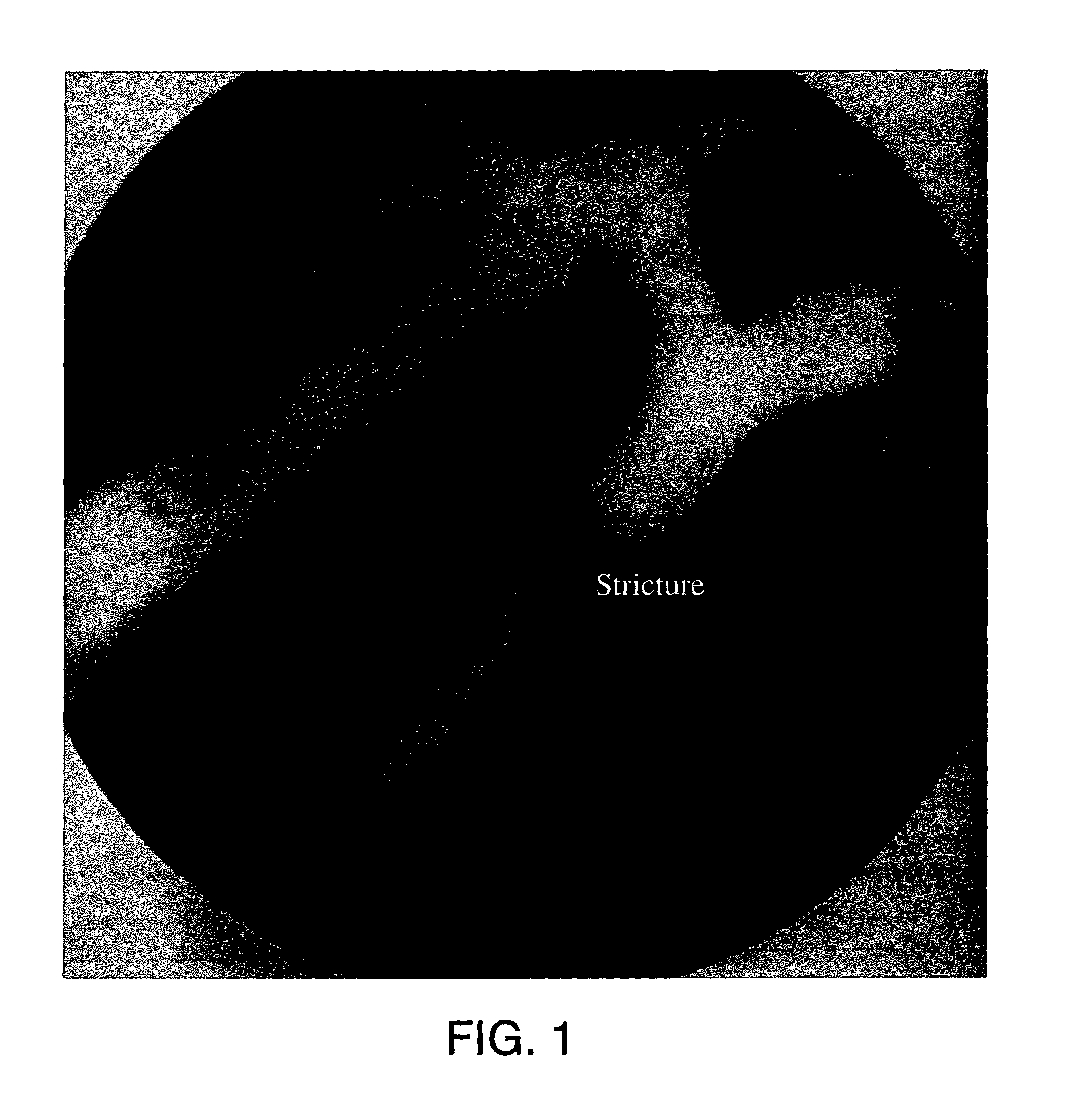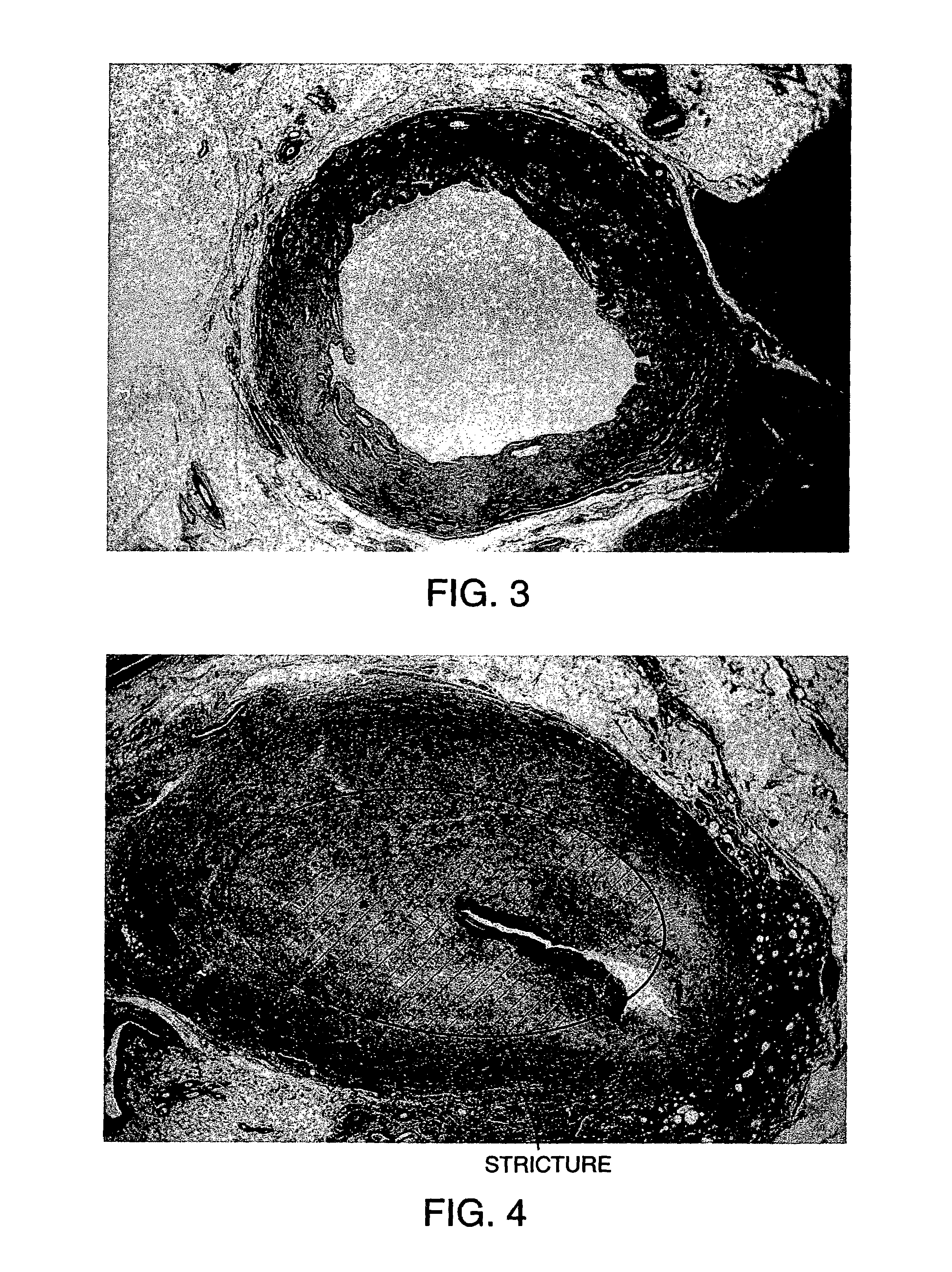Methods for treating an artery or vein in a human subject
a technology of biological conduits and arteries, which is applied in the direction of medical preparations, pharmaceutical active ingredients, peptide/protein ingredients, etc., can solve the problems of obstructing tissue removal by dilation methods, no treatment that can sustain patency, and frequent obstruction of biological conduits
- Summary
- Abstract
- Description
- Claims
- Application Information
AI Technical Summary
Benefits of technology
Problems solved by technology
Method used
Image
Examples
example 1
Tissue Digestion Analysis
[0059]The protocol of the following example is a detailed description of a “standard in vitro tissue digestion assay” as referred to herein.
[0060]The rate of tissue digestion, which is composed mostly of collagen, by a mixture of collagenase and elastase, proteolytic enzymes with activity respectively against collagen and elastin, was determined. Trypsin inhibitor was added to negate the effect of any residual trypsin activity. Briefly, fresh pig tendon was excised, trimmed, washed, blotted dry and weighed. Individual tendon pieces were suspended in 3.58 mg / ml HEPES buffer at neutral pH and various concentrations of enzymes were added. Iodinated radiographic contrast was added in various concentrations to some of the enzyme solutions. The tissue digestion was carried out in a water bath at 37° C. At various time points, the tendon pieces were removed from the enzyme solution, washed, blotted dry and weighed. Each time point was derived from the average of th...
example 2
Determining Dose Dependent In Vitro Activity of a Therapeutic Agent Including Collagenase, Elastase, and a Trypsin Inhibitor
[0062]The effect of enzyme concentration on tissue digestion rates was studied (FIG. 3). The “1×” tissue sample was treated with collagenase 156 Mandel units / ml+elastase 0.125 mg / ml+trypsin inhibitor 0.38 mg / mg, The “2×” sample was treated with collagenase 312 Mandel units / ml+elastase 0.25 mg / ml+trypsin inhibitor 0.76 mg / ml. The “5×” sample was treated with collagenase 780 Mandel units / ml+elastase 0.625 mg / ml+trypsin inhibitor 1.9 mg / ml. All digestion volumes were 0.5 ml. Increasing the concentration of enzymes in vitro increased the rate of tissue digestion (FIG. 3). Buffer alone had no effect on the tissue. An effective in vivo dose was found to be 10,000 ABC units.
example 3
Determining the Effect of Iodinated Radiographic Contrast Material on Tissue Digestion Rates to Facilitate Monitoring Enzyme Delivery Prior to Injection of a Therapeutic Agent Comprising a Contrast Material into a Patient
[0063]The “35% Omnipaque” tissue sample was treated with collagenase 156 Mandel units / ml+elastase 0.125 mg / ml+0.38 trypsin inhibitor with 35% Onmipaque 350 contrast (volume:volume). The “5% Omnipaque” sample was treated with collagenase 312 Mandel units / ml+elastase 0.25 mg / ml+0.76 trypsin inhibitor with 5% Omnipaque 350 (volume:volume). The “1% Onmipaque” sample was treated with collagenase 312 Mandel units / ml+elastase 0.25 mg / ml+0.76 trypsin inhibitor with 1% Omnipaque 350. All digestion volumes were 0.5 ml. These results demonstrate that Omnipaque 350 iodinated contrast material inhibits enzyme activity at radiographically visible (35%) concentrations, but not at lower (1–5%) concentrations (FIG. 4). Similar results were observed with Hypaque 60 contrast.
PUM
| Property | Measurement | Unit |
|---|---|---|
| Diameter | aaaaa | aaaaa |
| Volume | aaaaa | aaaaa |
Abstract
Description
Claims
Application Information
 Login to View More
Login to View More - R&D
- Intellectual Property
- Life Sciences
- Materials
- Tech Scout
- Unparalleled Data Quality
- Higher Quality Content
- 60% Fewer Hallucinations
Browse by: Latest US Patents, China's latest patents, Technical Efficacy Thesaurus, Application Domain, Technology Topic, Popular Technical Reports.
© 2025 PatSnap. All rights reserved.Legal|Privacy policy|Modern Slavery Act Transparency Statement|Sitemap|About US| Contact US: help@patsnap.com



